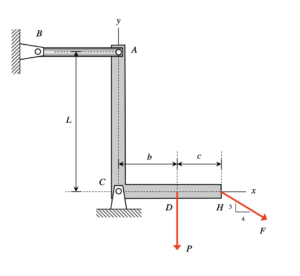Problem statement
Solution video
DISCUSSION THREAD

Please post questions here on the homework, and take time to answer questions posted by others. You can learn both ways.
Problem statement
Solution video
DISCUSSION THREAD

You must be logged in to post a comment.
Would the load carried by rod AB just be the moment of C where we would have to solve for the tension force of AB in order to determine the axial stress and strain?
Yes I believe so. That is what I did
Is the rod pinned to the frame at point A (so angle BAC isn't always 90 and therefore there is a BAy force) or is it fixed at 90 so there is only 1 force that can be found directly via the moment about C?
BA is a 2 force member only in the x direction. Hope that helps.
Based on the diagram, it looks like the joint at A is a pin joint.
Is "d" just generally assumed to be the diameter for area calculations? I'm assuming it is because it's not on the diagram, but not sure.
The "Given" section says that rod AB has a diameter of d.
Yes, we can use the given "d" value to solve for the cross sectional area of the member to solve for the stress on the member.
I understand that the axial load is uniformly distributed across the cross section of the member, but does this also mean that the distribution is the same for all cross sections along the length of the member?
Ultimately, the value that we look for when finding the axial load is going to be the total axial load, which is then just divided by cross sectional area to find the axial stress. Therefore, the details of the distribution of the load across AB (I'm assuming this is the member in question) is going to be irrelevant for the purposes of solving this problem.
What units should our answer be in?
I think for load: kips,
for axial stress: psi,
for the strain, by definition, it should be in/in as you're dividing two lengths to measure the strain.
I believe for axial stress you could also use kips, and the strain could be dimensionless.
Axial stress would have to be in pressure units, so you could use ksi, not kips. It would probably make the most sense to use psi because the Young’s modulus is in psi, so you can easier find the axial strain.
For the load you could convert from kips to lbs (multply by 1,000) that way when you calculate the stress your answer will already be in psi. Then for strain you'll have in/in (or unitless).
If joints are pinned at least for this class I would say it's safe to assume always 90 otherwise it would be stated. You can then split the Frame into Rba and the L-shaped bracket. This way you can just take the moment at point C and this will give you the two force members between the split.
And we use the equation sigma AB = E times axial strain to solve for axial strain correct?
So I have used (axial stress)/E(given) to solve axial strain
Do we need to know the length in AB?
In this problem, we first solve for tension AB and then find the total axial load and then divide it by cross sectional area to find the axial stress.
While I was reviewing this question, I did sum of force in x direction to calculate for the load on AB, but this is incorrect. Remember to do moment on C to get load on AB.